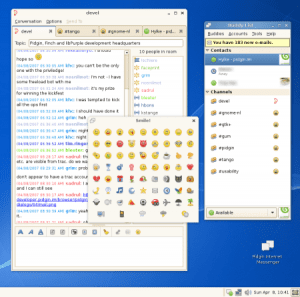One approach to understanding features of IM use is to examine the nature of the medium itself. This approach follows the general outline of media richness theory. Media richness theory compares the communicative capacities of different technologies according to fundamental properties such as “the medium’s capacity for immediate feedback, the number of cues and channels utilized, personalization, and language variety”. These properties contribute to the “richness” of a medium, which describes the capacity of the medium for carrying information. Communicative media are ordered according to their richness; face-to-face communication, for example, with its rich range of nonverbal cues, is a richer medium than telephone conversations, but the telephone is richer than formal, written communication. The richness of a medium determines its utility for different kinds of interaction.
 Medium of IM: Attributes
Medium of IM: Attributes
Drawing on this perspective, research related to IM often point out particular properties of this medium that seem to support its informality. In particular, the informality of IM is often attributed to three characteristics: that it is synchronous, lightweight, and ephemeral.
Synchronous
IM’s synchronous character is central. Isaacs et al. (2002) observed that IM conversation is characterized by “rapid exchanges (e.g. questions and answers) and brief interactions.” Nardi et al. (2000) concluded “a key reason for this informality lies in the near-synchronous nature of IM. Conversations can be more interactive because the rapid and evolving nature of IM means that there is immediate context for the current interaction.” It is more important to be contributing to the flow of the dialogue than to be careful in crafting a response. What results in an IM dialogue is “relaxed grammar, spelling, and capitalization typically creating a causal, informal, and friendly tenor of instant messages”.
Lightweight
IM imposes little overhead to engaging in a conversation. Accordingly, IM supports exchanges to which email would be poorly suited, such as quick questions and social greetings. IM users often found that IM was “less disruptive than the phone” (Tang et al., 2001). Nardi et al. (2000) pointed out, “an important reason for choosing IM over other media for [quick questions] is its efficiency: IM allows more rapid exchanges than is possible with email but without the overhead of a full-blown face to face conversation.” It is often easy to initiate and end a conversation because “IM enables the user to eliminate certain formalities of address associated with phone and email” (Nardi et al., 2000). Similarly, Isaacs et al. (2002) describe IM as “highly effective … for asking quick questions without the overhead of telephone or FTF interaction.”
Ephemeral
Email is now broadly perceived to be a permanently stored medium, where old messages can be recovered for uses including litigation. In contrast, IM logs are not yet widely retained and restored, which is another property to which the medium’s informality has been attributed. For example, Lovejoy and Grudin (2003) suggest that recording communication makes people more guarded; “Ephemeral interaction is conducive to informality … knowing that an exchange could reappear unexpectedly in the future could lead people to be less casual, less informal.” They conclude that “if recording of IM becomes commonplace, it is likely to lead to greater formality.”
Medium of IM: Implications
All of these accounts suggest, then, that an explanation of the informal nature of IM (and, by implication, the formal nature of email) is to be found in the properties of the medium itself.
However, while it is valuable to compare media according to their technical properties, the media-centric approach does not fully explain the context of communication, especially when we start to talk of such complex factors as “formality.” More specifically, the media-centric argument has difficulty explaining how media can be transformed from “informal” to “formal” if their underlying technological properties do not change significantly. Email is an example of one medium that has somehow made this transition, and we believe an analysis of how and why email became formal offers alternative explanations for media selection and usage. In contrast to media richness approaches, we believe a more adequate explanation lies beyond the IM medium, in the nature of the institutional arrangements that shape and govern access to and encounters with media.
